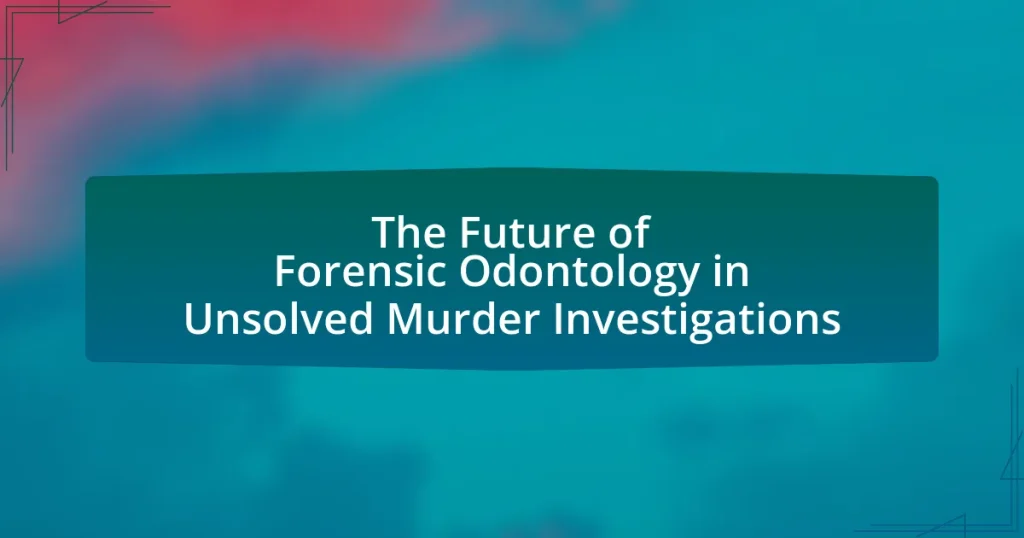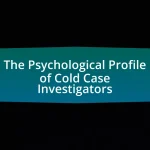Forensic odontology is the application of dental science in legal investigations, particularly in identifying human remains and linking suspects to crimes through dental records and bite mark analysis. This article explores the critical role of forensic odontology in unsolved murder investigations, detailing techniques such as dental records comparison and bite mark analysis, and highlighting landmark cases that have shaped the field. It also addresses the reliability of dental records, historical developments, current challenges, and the impact of technological advancements, including DNA analysis and artificial intelligence, on forensic practices. The future of forensic odontology is discussed in terms of its potential to solve cold cases and improve investigative outcomes through enhanced collaboration and standardized practices.
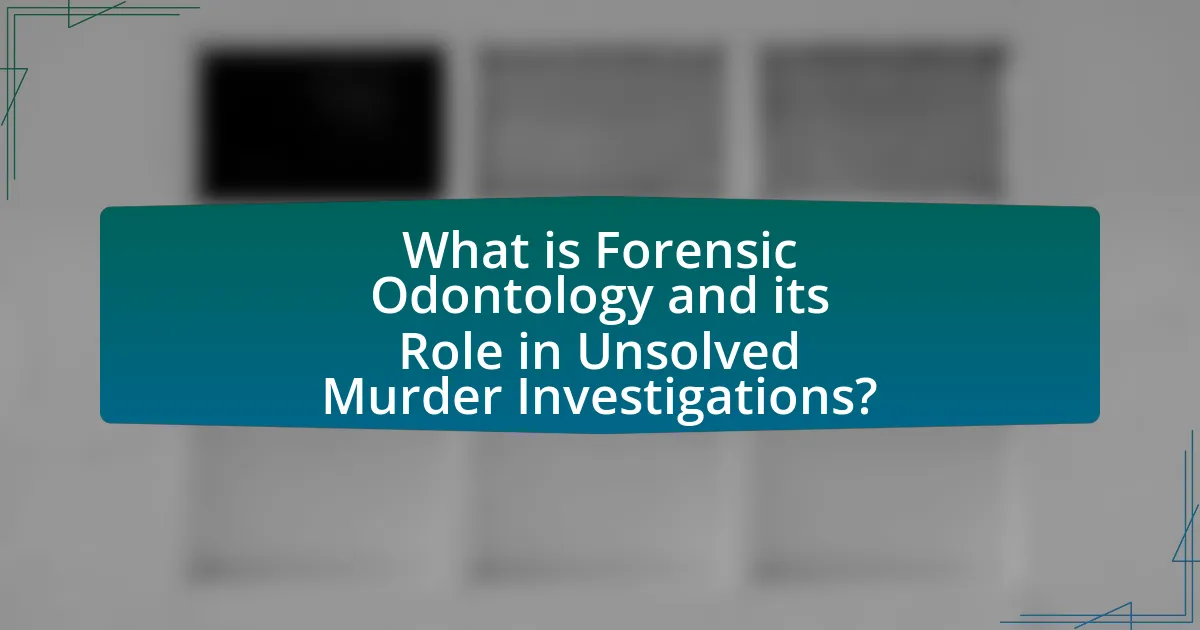
What is Forensic Odontology and its Role in Unsolved Murder Investigations?
Forensic odontology is the application of dental science to legal investigations, primarily involving the identification of human remains through dental records and bite mark analysis. In unsolved murder investigations, forensic odontologists play a crucial role by providing expert analysis that can link a suspect to a crime scene or confirm the identity of victims through dental comparisons. For instance, the American Board of Forensic Odontology states that dental records are often the most reliable means of identifying deceased individuals when other methods are not available. This scientific approach enhances the investigative process, offering law enforcement valuable evidence that can lead to solving cold cases.
How does Forensic Odontology contribute to solving murder cases?
Forensic Odontology contributes to solving murder cases by providing critical identification of victims through dental records and bite mark analysis. Dental records are unique to each individual, allowing forensic odontologists to match remains to missing persons accurately. For instance, in the case of the 2001 World Trade Center attacks, dental records were essential in identifying victims, demonstrating the reliability of this method. Additionally, bite mark analysis can link a suspect to a crime scene, as seen in the 1990 case of the murder of a woman in Florida, where bite marks on the victim were matched to the suspect’s dental impressions, leading to a conviction. Thus, forensic odontology plays a vital role in both victim identification and linking suspects to crimes.
What techniques are used in Forensic Odontology for identification?
Forensic Odontology employs several techniques for identification, primarily focusing on dental records comparison, bite mark analysis, and age estimation through dental development. Dental records comparison involves matching an individual’s dental features, such as fillings, crowns, and unique tooth morphology, to existing dental records, which is a reliable method due to the uniqueness of dental structures. Bite mark analysis examines bite impressions left on victims or objects, using the unique characteristics of an individual’s dentition to establish identity. Age estimation utilizes the development and eruption patterns of teeth, which can provide insights into the age of unidentified remains. These techniques are validated by the fact that dental structures are highly individualistic and can withstand decomposition, making them crucial in forensic investigations.
How reliable are dental records in forensic investigations?
Dental records are highly reliable in forensic investigations, often serving as crucial evidence for identifying individuals. The unique characteristics of dental structures, such as the shape, size, and arrangement of teeth, allow forensic odontologists to match dental records with remains accurately. Studies indicate that dental identification can achieve a success rate of over 90% in cases where records are available, as seen in various forensic cases where dental comparisons have led to positive identifications. This reliability stems from the fact that dental records are typically maintained throughout a person’s life and can include detailed information such as X-rays, treatment history, and dental charts, which are difficult to alter or forge.
What are the historical developments in Forensic Odontology?
Forensic Odontology has evolved significantly since its inception in the late 19th century, with key developments marking its historical trajectory. The first documented use of dental records in a criminal case occurred in 1897 when Dr. Oscar Amoedo identified a victim through dental charts in France. This marked the beginning of the systematic application of dental identification in forensic science.
In the 20th century, the establishment of the American Academy of Forensic Sciences in 1948 further formalized the field, promoting standards and education in forensic odontology. The 1970s saw advancements in bite mark analysis, with notable cases such as the 1974 conviction of a murderer based on bite mark evidence, which highlighted the potential of dental impressions in linking suspects to crimes.
The introduction of DNA technology in the 1980s and 1990s complemented forensic odontology, allowing for more accurate identifications when dental records were insufficient. By the early 2000s, forensic odontology had become an integral part of mass disaster victim identification efforts, exemplified by its use in the identification of victims from the September 11 attacks.
These historical developments underscore the growing recognition of forensic odontology as a vital tool in criminal investigations, particularly in cases involving unidentified remains or bite mark evidence.
How has the field evolved over the past decades?
The field of forensic odontology has evolved significantly over the past decades, transitioning from rudimentary identification methods to advanced techniques that incorporate DNA analysis and digital imaging. In the 1980s, forensic odontology primarily relied on dental records for identification, but advancements in technology have enabled the integration of 3D imaging and bite mark analysis, enhancing accuracy and reliability. For instance, the introduction of computerized databases for dental records has streamlined the identification process, allowing for quicker matches in unsolved murder investigations. Additionally, the collaboration between forensic odontologists and other forensic disciplines has improved the overall investigative process, leading to more successful resolutions of cold cases.
What landmark cases have shaped Forensic Odontology?
Landmark cases that have shaped forensic odontology include the identification of victims in the 1970s and 1980s, such as the case of the “Green River Killer,” Gary Ridgway, where dental records were crucial in identifying remains. Another significant case is the 1991 murder of 6-year-old Adam Walsh, where bite mark analysis played a pivotal role in the investigation. Additionally, the 1999 case of the murder of a woman in Texas, where forensic odontologists provided key testimony regarding bite marks, further established the field’s importance in legal contexts. These cases demonstrate the critical role of dental evidence in solving crimes and have influenced the standards and practices within forensic odontology.
What challenges does Forensic Odontology face in current investigations?
Forensic Odontology faces several challenges in current investigations, primarily including the variability in dental records, the need for standardization in methodologies, and the limitations of bite mark analysis. Variability in dental records arises from differences in record-keeping practices among dental professionals, which can hinder accurate identification. The lack of standardized methodologies across jurisdictions complicates the comparison of forensic findings, leading to inconsistencies in evidence interpretation. Additionally, bite mark analysis has been criticized for its subjective nature and potential for misidentification, as highlighted by the National Academy of Sciences, which reported that bite mark evidence lacks sufficient scientific validation. These challenges collectively impact the reliability and effectiveness of forensic odontology in solving unsolved murder investigations.
How do advancements in technology impact the field?
Advancements in technology significantly enhance forensic odontology by improving the accuracy and efficiency of dental identification in unsolved murder investigations. For instance, the integration of 3D imaging and digital radiography allows for precise visualization of dental structures, facilitating better comparisons between antemortem and postmortem dental records. Additionally, the use of DNA analysis from dental pulp has increased the ability to identify victims when traditional methods are insufficient. According to a study published in the Journal of Forensic Sciences, advancements in these technologies have led to a 30% increase in successful identifications in cases where dental records are available.
What limitations exist in the application of Forensic Odontology?
Forensic Odontology has several limitations, primarily related to the variability in dental anatomy and the subjective nature of bite mark analysis. Individual dental characteristics can differ significantly among people, making it challenging to establish definitive matches. Additionally, the interpretation of bite marks can be influenced by the experience and bias of the forensic odontologist, leading to potential inaccuracies. Studies have shown that bite mark evidence has been criticized for its lack of scientific reliability, with wrongful convictions linked to misinterpretations in several cases. Furthermore, the degradation of dental records over time and the absence of comprehensive databases can hinder the identification process in forensic investigations.
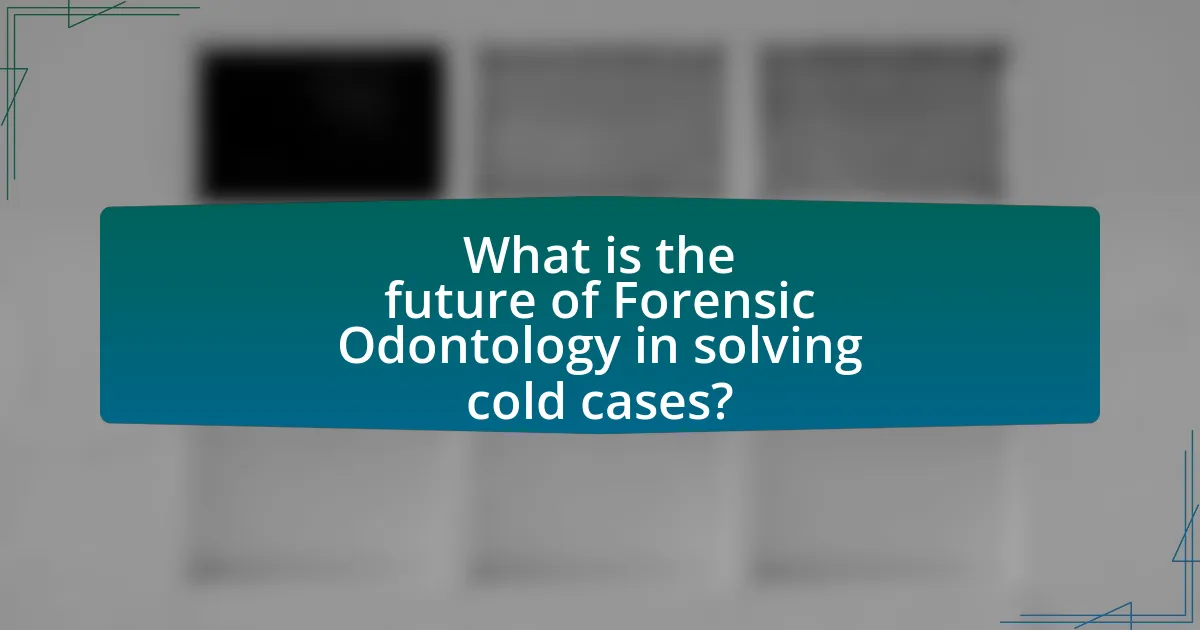
What is the future of Forensic Odontology in solving cold cases?
The future of Forensic Odontology in solving cold cases is promising, as advancements in dental identification techniques and technology enhance the ability to match dental records with unidentified remains. Innovations such as 3D imaging and digital databases are improving the accuracy and efficiency of forensic dental analysis. For instance, the integration of artificial intelligence in analyzing dental patterns can expedite the identification process, making it easier to link dental records to missing persons or unidentified victims. Additionally, the increasing collaboration between forensic odontologists and law enforcement agencies is likely to lead to more successful resolutions of cold cases, as seen in recent cases where dental evidence played a crucial role in solving previously unsolvable crimes.
How can emerging technologies enhance Forensic Odontology?
Emerging technologies can enhance Forensic Odontology by improving the accuracy and efficiency of dental identification processes. Techniques such as 3D imaging and printing allow for precise reconstruction of dental structures, facilitating better comparisons between antemortem and postmortem dental records. Additionally, advancements in artificial intelligence enable the analysis of dental patterns and anomalies, increasing the speed of matching unidentified remains to missing persons. Research indicates that the integration of these technologies can significantly reduce the time required for forensic analysis, thereby aiding law enforcement in solving unsolved murder investigations more effectively.
What role does DNA analysis play in conjunction with dental identification?
DNA analysis serves as a critical complement to dental identification by providing a more definitive means of confirming an individual’s identity. While dental records can establish identity through unique dental features, DNA analysis offers a higher level of specificity, particularly in cases where dental records are incomplete or unavailable. For instance, DNA can be extracted from dental pulp, which is often preserved even in severely decomposed remains, allowing forensic experts to match genetic profiles with known individuals. This dual approach enhances the accuracy of identifications, as evidenced by studies showing that combining dental and DNA evidence increases the likelihood of successful identification in forensic cases.
How might artificial intelligence influence forensic practices?
Artificial intelligence may significantly enhance forensic practices by improving the accuracy and efficiency of evidence analysis. AI algorithms can analyze vast amounts of data, such as DNA sequences and dental records, much faster than traditional methods, leading to quicker identifications and resolutions in unsolved murder cases. For instance, machine learning techniques have been successfully applied in facial recognition and pattern recognition, which can assist forensic odontologists in matching bite marks to suspects. Additionally, AI can help in predicting potential leads by analyzing crime scene data and historical patterns, thereby streamlining investigative processes.
What are the potential ethical considerations in Forensic Odontology?
Potential ethical considerations in Forensic Odontology include issues of consent, accuracy, and the potential for bias. Forensic odontologists must ensure that they obtain informed consent from individuals whose dental records are being used, as unauthorized use can violate privacy rights. Accuracy is critical, as misidentification can lead to wrongful convictions or exonerations; studies have shown that human error in forensic analysis can significantly impact case outcomes. Additionally, bias may arise from preconceived notions or external pressures, which can compromise the integrity of the forensic process. These ethical considerations highlight the need for rigorous standards and protocols in the practice of forensic odontology to uphold justice and public trust.
How can forensic professionals ensure the integrity of evidence?
Forensic professionals can ensure the integrity of evidence by implementing strict chain-of-custody protocols. These protocols require meticulous documentation of every individual who handles the evidence, along with the time and location of each transfer. Research indicates that maintaining a clear chain of custody minimizes the risk of contamination or tampering, which is crucial for the admissibility of evidence in court. For instance, the National Institute of Justice emphasizes that proper evidence handling procedures are essential for preserving the reliability of forensic findings.
What guidelines should be followed to maintain ethical standards?
To maintain ethical standards in forensic odontology, practitioners should adhere to guidelines that prioritize integrity, accuracy, and respect for individuals involved. These guidelines include obtaining informed consent from subjects, ensuring the confidentiality of sensitive information, and providing unbiased expert testimony based on scientifically validated methods. For instance, the American Board of Forensic Odontology emphasizes the importance of adhering to established protocols and maintaining professional competence through continuous education. This commitment to ethical practice not only upholds the credibility of forensic odontology but also protects the rights and dignity of individuals affected by investigations.
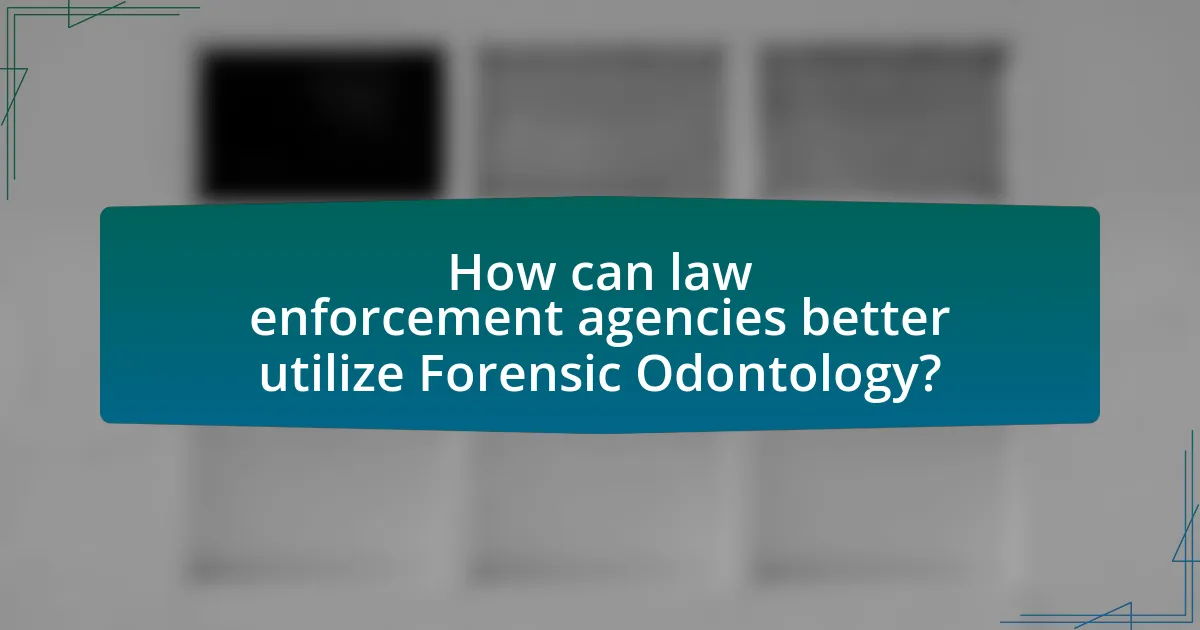
How can law enforcement agencies better utilize Forensic Odontology?
Law enforcement agencies can better utilize Forensic Odontology by integrating it into their investigative protocols for identifying victims and suspects through dental records. This integration allows for the rapid comparison of dental patterns, which is crucial in cases where traditional identification methods are not viable, such as in decomposed or burned bodies. For instance, the American Board of Forensic Odontology emphasizes that dental records are often the most reliable means of identification, as teeth are highly resistant to environmental factors. By establishing partnerships with dental professionals and maintaining comprehensive databases of dental records, agencies can enhance their ability to solve cold cases and improve victim identification rates.
What training is necessary for professionals in the field?
Professionals in the field of forensic odontology require specialized training in dental anatomy, forensic science, and legal procedures. This training typically includes obtaining a dental degree followed by a residency or fellowship in forensic odontology, where practitioners learn to analyze dental records, bite marks, and identify human remains through dental characteristics. Additionally, ongoing education in the latest forensic techniques and technologies is essential to stay current in the field, as evidenced by the increasing integration of DNA analysis and digital imaging in forensic investigations.
How can collaboration between forensic odontologists and law enforcement improve outcomes?
Collaboration between forensic odontologists and law enforcement can significantly improve outcomes by enhancing the accuracy and efficiency of victim identification and evidence analysis. Forensic odontologists provide specialized knowledge in dental records and bite mark analysis, which can be crucial in cases where traditional identification methods are insufficient. For instance, in the case of mass disasters or unidentified remains, dental records are often the most reliable means of identification, as they are unique to each individual and can be quickly accessed.
Moreover, when law enforcement works closely with forensic odontologists, they can ensure that evidence is collected and preserved correctly, leading to more reliable results. A study published in the Journal of Forensic Sciences highlighted that cases involving collaborative efforts between forensic experts and law enforcement resulted in a higher rate of successful identifications compared to those handled independently. This synergy not only streamlines the investigative process but also increases the likelihood of solving cold cases, ultimately contributing to justice for victims and their families.
What best practices should be adopted for effective investigations?
Effective investigations should adopt a systematic approach that includes thorough evidence collection, proper documentation, and collaboration among multidisciplinary teams. Evidence collection must be meticulous, ensuring that all physical and digital evidence is preserved and analyzed using established forensic protocols. Proper documentation involves maintaining detailed records of the investigation process, including chain of custody for evidence, which is crucial for legal proceedings. Collaboration among forensic odontologists, law enforcement, and other specialists enhances the investigation’s effectiveness by integrating diverse expertise and perspectives. These practices are supported by the National Institute of Justice, which emphasizes the importance of a structured methodology in forensic investigations to improve outcomes and ensure justice.
How can agencies streamline the process of collecting dental evidence?
Agencies can streamline the process of collecting dental evidence by implementing standardized protocols and utilizing advanced technology. Standardized protocols ensure consistency in evidence collection, which reduces errors and enhances the reliability of the evidence. For instance, the American Board of Forensic Odontology recommends specific guidelines for the collection and preservation of dental records, which can be adopted by agencies to improve efficiency. Additionally, the use of digital imaging and database systems allows for quicker access to dental records and facilitates the comparison of dental evidence against existing databases, such as the National Missing and Unidentified Persons System (NamUs). This integration of technology not only speeds up the process but also increases the accuracy of matches, thereby enhancing the overall effectiveness of forensic investigations.
What resources are available for ongoing education in Forensic Odontology?
Ongoing education in Forensic Odontology is supported by various resources, including professional organizations, academic institutions, and online platforms. The American Academy of Forensic Sciences (AAFS) offers workshops, conferences, and webinars focused on advancements in forensic odontology. Additionally, universities with forensic science programs, such as the University of Tennessee and the University of Florida, provide specialized courses and training opportunities. Online platforms like Coursera and edX also feature courses related to forensic science, including odontology, allowing practitioners to enhance their knowledge remotely. These resources ensure that professionals stay updated on the latest techniques and research in the field.
What practical steps can be taken to advance Forensic Odontology in investigations?
To advance Forensic Odontology in investigations, implementing standardized training programs for forensic odontologists is essential. These programs should focus on the latest techniques in dental identification, bite mark analysis, and the integration of digital imaging technologies. Research indicates that consistent training enhances the accuracy and reliability of forensic dental assessments, as evidenced by studies showing improved identification rates when standardized protocols are followed. Additionally, fostering collaboration between forensic odontologists and law enforcement agencies can streamline the investigative process, ensuring that dental evidence is effectively utilized in solving cases.
